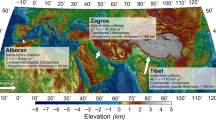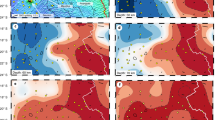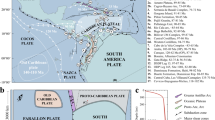Abstract
The subduction of oceanic lithosphere plays a key role in plate tectonics, the thermal evolution of the mantle and recycling processes between Earth's interior and surface. Information on mantle flow, thermal conditions and chemical transport in subduction zones come from the geochemistry of arc volcanoes1,2,3, seismic images4,5 and geodynamic models6,7,8,9,10. The majority of this work considers subduction as a two-dimensional process, assuming limited variability in the direction parallel to the trench. In contrast, observationally based models increasingly appeal to three-dimensional flow associated with trench migration and the sinking of oceanic plates with a translational component of motion11 (rollback). Here we report results from laboratory experiments that reveal fundamental differences in three-dimensional mantle circulation and temperature structure in response to subduction with and without a rollback component. Without rollback motion, flow in the mantle wedge is sluggish, there is no mass flux around the plate and plate edges heat up faster than plate centres. In contrast, during rollback subduction flow is driven around and beneath the sinking plate, velocities increase within the mantle wedge and are focused towards the centre of the plate, and the surface of the plate heats more along the centreline.
This is a preview of subscription content, access via your institution
Access options
Subscribe to this journal
Receive 51 print issues and online access
$199.00 per year
only $3.90 per issue
Buy this article
- Purchase on Springer Link
- Instant access to full article PDF
Prices may be subject to local taxes which are calculated during checkout




Similar content being viewed by others
References
McCulloch, M. T. & Gamble, J. A. Geochemical and geodynamical constraints on subduction zone magmatism. Earth Planet. Sci. Lett. 102, 358–374 (1991)
Woodhead, J., Eggins, S. & Gamble, J. High field strength and transition element systematics in island arc and back-arc basin basalts: Evidence for multi-phase melt extraction and a depleted mantle wedge. Earth Planet. Sci. Lett. 114, 491–504 (1993)
Turner, S. & Hawkesworth, C. Constraints on flux rates and mantle dynamics beneath island arcs from Tonga-Kermadec lava geochemistry. Nature 389, 568–573 (1997)
Zhao, D., Hasegawa, A. & Horiuchi, S. Tomographic imaging of P and S wave velocity structure beneath Northeastern Japan. J. Geophys. Res. 97, 19909–19928 (1992)
Koper, K. D., Weins, D. A., Dorman, L. M., Hildebrand, J. A. & Webb, S. C. Constraints on the origin of slab and wedge anomalies in Tonga from the ratio of S to P anomalies. J. Geophys. Res. 104, 15089–15104 (1999)
Hsui, A. T., Marsh, B. D. & Toksoz, M. N. On melting of the subducted oceanic crust: Effects of subduction induced mantle flow. Tectonophysics 99, 207–220 (1983)
Davies, J. H. & Stevenson, D. J. Physical model of source region of subduction zone volcanics. J. Geophys. Res. 97, 2037–2070 (1992)
Peacock, S., Rushmer, T. & Thompson, A. Partial melting of subducting oceanic crust. Earth Planet. Sci. Lett. 121, 227–244 (1994)
Kincaid, C. & Sacks, I. S. The thermal and dynamical evolution of the upper mantle in subduction zones. J. Geophys. Res. 102, 12295–12315 (1997)
Kincaid, C. & Hall, P. S. The role of back-arc spreading in circulation and melting at subduction zones. J. Geophys. Res. 208, 2240–2254 (2003)
Elssasser, W. M. Sea floor spreading and thermal convection. J. Geophys. Res. 76, 1101–1111 (1971)
Klosko, E. et al. Upper mantle flow in the New Zealand region from seismic anisotropy. Geophys. Res. Lett. 26, 1497–1500 (1999)
Russo, R. & Silver, P. Cordillera formation, mantle dynamics and the Wilson cycle. Geology 24, 511–514 (1996)
Peyton, V. et al. Mantle flow at a slab edge: Seismic anisotropy in the Kamchatka region. Geophys. Res. Lett. 28, 379–382 (2001)
Pearce, J. A., Leat, P. T., Barker, P. F. & Millar, I. L. Geochemical tracing of Pacific-to-Atlantic upper-mantle flow through the Drake Passage. Nature 410, 457–461 (2001)
Turner, S. & Hawkesworth, C. Using geochemistry to map mantle flow beneath the Lau Basin. Geology 26, 1019–1022 (1998)
Wendt, J. I., Regelous, M., Collerson, K. D. & Ewart, A. Evidence for a contribution from two mantle plumes to the island-arc lavas from northern Tonga. Geology 25, 611–614 (1997)
Yogodzinski, G. M. et al. Geochemical evidence for the melting of subducting oceanic lithosphere at plate edges. Nature 409, 500–504 (2001)
Gvirtzman, Z. & Nur, A. The formation of Mount Etna as the consequence of slab rollback. Nature 401, 782–785 (1999)
Hudson, J. D. & Dennis, S. C. R. The flow of a viscous incompressible fluid past a normal flat plate at low and intermediate Reynolds numbers: The wake. J. Fluid Mech. 160, 369–383 (1985)
Garfunkel, Z., Anderson, C. A. & Schubert, G. Mantle circulation and the lateral migration of subducted slabs. J. Geophys. Res. 91, 7205–7223 (1986)
Ribe, N. Mantle flow induced by back-arc spreading. Geophys. J. Int. 98, 85–91 (1989)
Kincaid, C. & Olson, P. An experimental study of subduction and slab migration. J. Geophys. Res. 92, 13832–13840 (1987)
Guillou-Frottier, L., Buttles, J. & Olson, P. Laboratory experiments on the structure of subducted lithosphere. Earth Planet. Sci. Lett. 133, 19–34 (1995)
Griffiths, R. W., Hackney, R. I. & van der Hilst, R. D. A laboratory investigation of effects of trench migration on the descent of subducted slabs. Earth Planet. Sci. Lett. 133, 1–17 (1995)
Buttles, J. & Olson, P. A laboratory model of subduction zone anisotropy. Earth Planet. Sci. Lett. 164, 245–262 (1998)
Sisson, T. W. & Bronto, S. Evidence for pressure-release melting beneath magmatic arcs from basalt at Galunggung, Indonesia. Nature 391, 883–886 (1998)
Drummond, M. S. & Defant, M. J. A model for trondhjemite-tonalite-dacite genesis and crustal growth via slab melting: Archean to modern comparisons. J. Geophys. Res. 95, 21503–21521 (1990)
Sigmarsson, O., Martin, H. & Knowles, J. Melting of a subducting oceanic crust from U-Th disequilibria in austral Andean lavas. Nature 394, 566–569 (1998)
van der Hilst, R. & Seno, T. Effects of relative plate motion on the deep structure and penetration depth of slabs below the Izu-Bonin and Mariana island arcs. Earth Planet. Sci. Lett. 120, 395–407 (1993)
Acknowledgements
This work benefited from the Margins TEI, held in August 2000 in Eugene, Oregon. We thank the Equipment Development Laboratory at URI-GSO, and T. Beasley and C. Morgan for technical assistance.
Author information
Authors and Affiliations
Corresponding author
Ethics declarations
Competing interests
The authors declare that they have no competing financial interests.
Rights and permissions
About this article
Cite this article
Kincaid, C., Griffiths, R. Laboratory models of the thermal evolution of the mantle during rollback subduction. Nature 425, 58–62 (2003). https://doi.org/10.1038/nature01923
Received:
Accepted:
Issue Date:
DOI: https://doi.org/10.1038/nature01923
This article is cited by
-
Interplay between oceanic subduction and continental collision in building continental crust
Nature Communications (2022)
-
Seismic evidence for subduction-induced mantle flows underneath Middle America
Nature Communications (2020)
-
The origin of arc basalts: New advances and remaining questions
Science China Earth Sciences (2020)
-
A subduction and mantle plume origin for Samoan volcanism
Scientific Reports (2018)
-
Seismogenesis of dual subduction beneath Kanto, central Japan controlled by fluid release
Scientific Reports (2017)
Comments
By submitting a comment you agree to abide by our Terms and Community Guidelines. If you find something abusive or that does not comply with our terms or guidelines please flag it as inappropriate.



